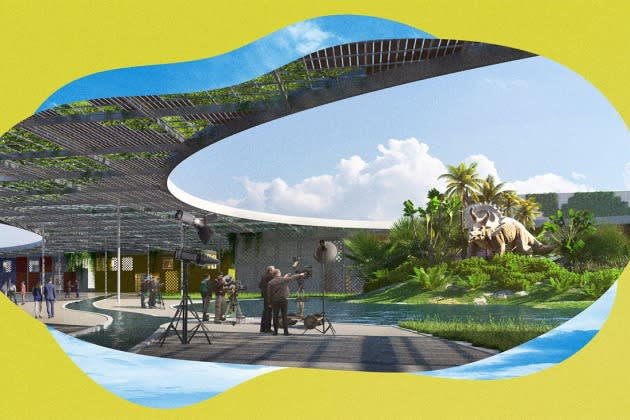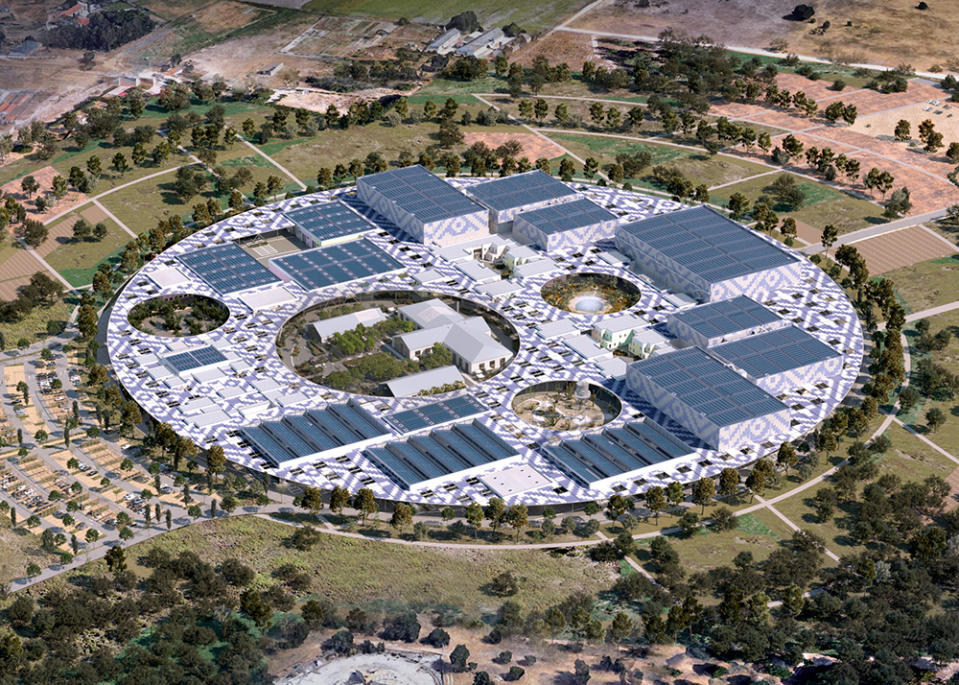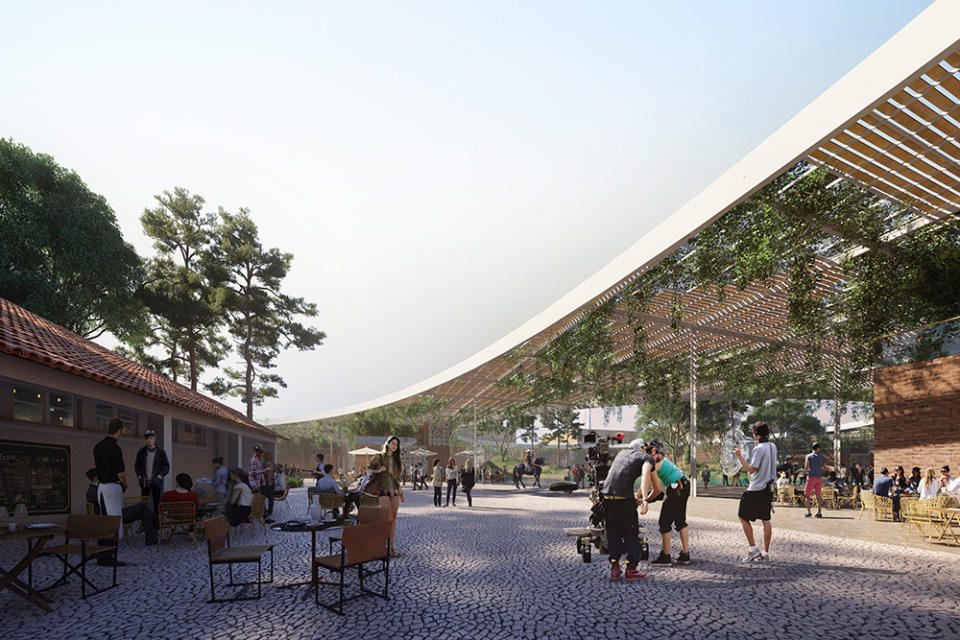Two New Studios Represent the Future of Green Filmmaking
- Oops!Something went wrong.Please try again later.
- Oops!Something went wrong.Please try again later.

This story is part of The Hollywood Reporter’s 2023 Sustainability Issue (click here to read more).
Going green in the film industry has gone from a vague ambition to an absolute necessity as the extent of Hollywood’s carbon footprint becomes impossible to ignore and as governments in Europe begin to make sustainability a factor in determining what projects get funding.
More from The Hollywood Reporter
The CO₂ impact of moviemaking is underreported, but the business is notoriously resource-hungry. The most recent study of the industry’s carbon footprint, put out by the Sustainable Production Alliance — a consortium of film, TV and streaming companies including all the major studios, as well as Amazon and Netflix — showed that tentpole productions, budgeted at more than $70 million, had an average carbon footprint of 3,370 metric tons, or about 33 metric tons per shooting day. Large films (between $40 million and $70 million) had a carbon footprint of 1,081 metric tons; medium films ($20 million to $40 million), 769 metric tons; and small films, budgeted at $20 million and below, a carbon footprint of 391 metric tons. For tentpole productions, fuel consumption made up nearly half of the CO₂ footprint, and air travel another 25 percent.
The figures were unchanged from the group’s first carbon emissions report in 2021.
If anything, the numbers likely underestimate the full environmental impact of film production, as they don’t take into account the energy used up in distribution — all those tons of CO₂ that go to stream video. The overall message is clear: Film is a dirty business, environmentally speaking, and the industry needs to clean up its act.
But, to misquote Kermit the Frog, it ain’t easy going green. In the British Film Institute’s A Screen New Deal, a 2021 study on the environmental impact of film production, the BFI noted that while most film practitioners want to reduce the carbon footprint of their productions, there are many institutional barriers to change, including a lack of low-impact infrastructure.

Now two new studios, one in the U.S., one in Europe, are looking to fix that problem by building backlots where sustainability is baked in. The Electric Owl Studios, located in Decatur, Georgia, just northeast of Atlanta, will open its doors June 8. Portugal’s 200 million euro ($215 million) Tage Studios project is set to break ground near the town of Palmela, southeast of Lisbon, in late 2024 or early 2025.
Both have been designed, top to bottom, with environmental sustainability in mind.
“We saw a gap in the market for studios that meet sustainability efforts,” says Electric Owl Studios’ Dan Rosenfelt. “We wanted to create something inspiring, to transform the industry.”
The Electric Owl Studios is a 312,000-square-foot production facility and, when Rosenfelt and partner Michael Hahn cut the ribbon June 8, it will be the first production studio worldwide to get, from the get-go, a LEED Gold certification, one of the highest levels of green-building ratings.
Efforts have been made at every stage to reduce the carbon footprint and generate clean energy, from using LED lighting and solar panels, to water refill stations, to food dehydrators that recycle craft services waste for landscaping reuse.
“I’ve been building film studios for almost 10 years now and [the construction] typically is a wasteful, wasteful industry,” says Hahn. “But quite a few things have improved — things like the switch from halogen-based, energy intensive lighting to LED lighting, to a new zero-carbon concrete product that’s now on the market. So we were able to plan a green building for only one percent of our budget. And we worked with consultants specific to the green industry to do that planning and achieve certification.”
Four thousand miles away, the group behind Tage Studios in Portugal is implementing many of the same technologies to create Europe’s first truly green studio. At the Tage backlot, every soundstage and facility building is designed to be a near-zero-energy structure, with rooftop photovoltaic panels providing electricity and rainwater recovery and reuse systems cutting down on water waste. Landscaping will be done to ensure preservation of local biodiversity. Even much of the material used for construction will be locally sourced and/or recycled, with at least 85 percent recovery of all site construction waste.
“The idea was to create a benchmark studio, one that will be eco-friendly and self-sustainable from day one,” says David Hallyday, founder and director of Tage Studios (and, in his day job, a French singer-songwriter and son of late Gallic rock legend Johnny Hallyday, aka the “French Elvis”). “When we started this project, five years ago now, we couldn’t find any studio anywhere that was designed like this, to be a green facility from the start.”
“There are a lot of measures that we are taking during construction to save resources, from water to energy to things like lighting and heating,” adds Maria Quiros Grande, a real estate director at consultancy giant Deloitte, which is advising Tage on the environmental design of the studio. “We know, for example, that our solar panel system will provide 100 percent of the energy consumption for the studio during the day and more than 50 percent overall.”
Tage Studios’ design will also take into account the operation’s broader environmental impact, with planners working with ecologists to preserve local biodiversity and reduce damage to flora and fauna in the region.

“Biodiversity is something that will be integrated into every stage of the project,” says Grande. “It impacts things as seemingly trivial as window design. All our windows will be deglazed to avoid bird collisions. And the lighting system will be such so that there is minimal light pollution, and operations at night do not disturb the nocturnal rhythms of the surrounding wildlife.”
Major European studio facilities, like London’s Pinewood and Studio Babelsberg outside Berlin, are incorporating green tech and environmental sustainability into their backlot designs, trying to retrofit their facilities to be more eco-friendly. Electric Owl and Tage Studios are among the first to attempt to go green from the get-go.
“There are no examples to follow,” says Hallyday. “Designing everything, from fixtures and equipment to the buildings and grounds, to meet both the highest environmental standards and to provide international productions with the top-level service and reliability they expect — we need this studio to be 24/7, 100 percent reliable and safe from day one — that’s been the biggest challenge.”
Both Tage and Electric Owl hope to set new industry standards for studio design, so that all future constructions will be green by default.
“We’d love for people to steal every idea we’ve had for our studio and even take it further,” says Rosenfelt of Electric Owl.
Tage Studios picked Portugal for reasons both practical — the coastal nation is among the world’s most solar-friendly, with an average of 300 days of sunshine per year (Hallyday calls it “the California of Europe”) — and political. The Portuguese government is a global leader in environmental policy and has set ambitious goals to reduce greenhouse gas emissions, increase the use of renewable energy, and promote eco-friendly practices.
“Portugal is extremely developed in the sense of sustainability — they are already producing nearly 60 percent of their energy via renewables,” notes Claire Havet, the project manager for Tage Studios. “Lisbon was named the Green Capital of Europe in 2020. We’ve been fully supported by the Portuguese government, who have declared our studio to be of national interest.”
Portugal’s sustainability push dovetails with the country’s move to try and catch up with neighbor Spain, which has enjoyed a film and TV boom over the past decade, fueled by increasing demand from local and global streaming services. Portugal, with its 30 percent tax incentive and stunning national vistas, has been successful in attracting some big international projects: Fast X, the latest in the decidedly carbon-heavy Fast and the Furious franchise, shot in the Viseu and Vila Real regions last spring; Netflix thriller Heart of Stone, starring Jamie Dornan and Gal Gadot, filmed scenes in the coastal town of Bordeira last summer. But the country still lacks a major sound studio.
Plans for Tage Studios would see the creation of a 5,200-square-meter (55,972 square feet) major soundstage along with six other stages ranging in size from 2,000 to 3,600 square meters (21,527 to 38,750 square feet), with an external backlot area of about 55,000 square meters (592,015 square feet) and an outdoor water tank. Once complete, the facility would be Europe’s largest in terms of studio space, ahead of Pinewood (419,793 square feet of soundstage), Warner Leavesden (381,042 square feet) and Babelsberg (301,389 square feet), though Warner’s huge backlot — more than 55 acres of available space — dwarfs even Tage’s ambitious plans.
The Portugal studio’s true competitive edge, however, could come from its planet-friendly design.
“Think about the technology available now from the ground up. This is not about retrofitting, it’s about state-of-the art innovation for our industry,” says Debbie Levin, CEO of the Environmental Media Association, which is consulting with Tage on the project. “We can’t wait to scream to the world about the opportunity to shoot in this magical, innovative environment.”
Major studios and streamers are now taking the environmental impact of a production into account when deciding where to shoot. And Europe’s entire state-backed film subsidy and tax incentive system is slowly going green. Producers in France will be obliged, as of next year, to submit carbon footprint audits as a condition of securing funding from national film body the CNC. Other national bodies are expected to follow suit. Europe’s Green New Deal, presented by European Commission President Ursula von der Leyen at the World Economic Forum in Davos in January, sets an ambitious target of making the continent climate-neutral by 2050, a goal that will put further pressure on Europe’s film and TV industry to start making CO₂ emissions a factor in funding decisions.
“Planning a studio the way we have, making sustainability and environmental impact a priority at every stage, is very, very expensive and very time consuming,” admits Hallyday. “But we really don’t have another option. This isn’t something we can do halfway. And we’re confident this is the way the industry is — has to be — in the future.”
Best of The Hollywood Reporter
Meet the World Builders: Hollywood's Top Physical Production Executives of 2023
Men in Blazers, Hollywood’s Favorite Soccer Podcast, Aims for a Global Empire

